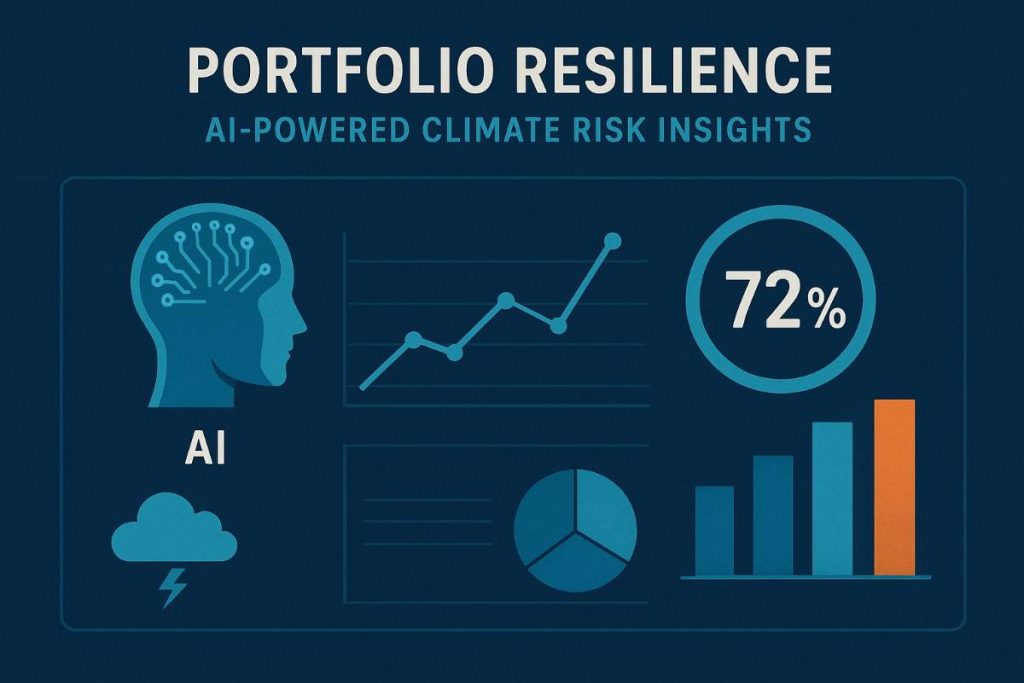Introduction: Why Climate Risk Finance Matters in 2025
In 2025, climate risk finance 2025 has become more than a buzzword—it’s a necessity. Rising global temperatures, extreme weather events, and shifting regulations are putting pressure on financial markets in ways investors can no longer ignore. Banks, asset managers, and insurers now recognize that climate risk is financial risk, and managing it is central to protecting portfolios.
Artificial intelligence (AI) is rapidly transforming how firms address this challenge. From climate stress testing to ESG data analytics, AI is reshaping the way financial institutions model future risks, uncover hidden exposures, and build resilience into investment strategies. Let’s explore how this shift is playing out in 2025.
What Is Climate Risk Finance2025?
Climate risk finance refers to the tools, models, and strategies investors use to account for the economic impacts of climate change. Unlike traditional financial analysis, which looks mainly at market volatility or credit risk, climate finance incorporates physical risks (storms, floods, heatwaves) and transition risks (policy changes, carbon pricing, shifting consumer demand).
From ESG to Climate Risk Modeling
A decade ago, the focus was on environmental, social, and governance (ESG) ratings. While ESG gave investors a starting point, it often lacked depth. Today, investors demand climate risk modeling—sophisticated simulations that test how portfolios might perform under different climate scenarios.

Instead of simply screening for “green” companies, analysts are asking: How would a two-degree global temperature rise impact cash flows, insurance losses, or energy prices?
How AI Powers Climate Stress Testing
Traditional stress testing relied on static assumptions, but AI makes it dynamic. By analyzing vast datasets—ranging from satellite imagery to carbon disclosures—AI models can forecast localized risks in ways humans cannot. For instance, an insurer can use AI to predict how rising sea levels affect mortgage-backed securities, while an asset manager can model how carbon taxes reshape energy sector valuations. This automation reduces guesswork and adds precision to portfolio resilience strategies.
The Role of AI in Climate Risk Finance 2025 Portfolio Resilience
Predictive Analytics for Climate Scenarios
AI excels at detecting weak signals in complex systems. Predictive analytics allows investors to run thousands of “what-if” climate scenarios, assessing probabilities of droughts, supply chain disruptions, or regional flooding. These simulations reveal potential losses before they occur, giving firms a head start in reallocating assets or hedging positions.

For example, a Canadian pension fund may use AI to identify which real estate holdings are most exposed to wildfire risks. Instead of divesting blindly, the fund can prioritize adaptation measures, such as insurance adjustments or infrastructure resilience investments.
Automating Risk Management with AI Climate Risk Finance 2025
Manual risk management can’t keep pace with the scale of modern climate threats. AI-driven platforms automate monitoring and reporting, flagging exposures in real time. If a company in an investor’s portfolio faces litigation over emissions disclosure, AI systems can immediately alert managers and suggest portfolio rebalancing. This kind of automation not only saves time but also reduces human error, a crucial factor when navigating high-stakes risks.
Opportunities in Climate Risk Finance 2025
Smarter ESG Data Analytics in Climate Risk Finance 2025
In 2025, ESG data is richer than ever, but it’s also overwhelming. AI provides a way to process unstructured information—climate disclosures, satellite images, social sentiment—into actionable insights. Instead of relying solely on third-party ESG scores, investors can now run their own analytics powered by AI.
This means more transparency and less reliance on “black box” ratings. For example, fintech startups are building AI dashboards that translate climate data into easy-to-understand financial indicators, democratizing access for retail investors as well as institutions.
Building Climate-Resilient Investment Portfolios
The biggest opportunity lies in constructing portfolios that are resilient by design. AI can help investors identify sectors poised for long-term growth in a low-carbon economy—renewables, green infrastructure, or water security. At the same time, it can flag industries likely to face headwinds, such as coal or high-emission transport.
By combining traditional asset allocation with climate-adjusted modeling, investors can balance profitability with sustainability. The result isn’t just “ethical investing,” but smarter investing that anticipates systemic risks before they erode returns.
Risks & Challenges
Data Limitations and Model Uncertainty
AI models are only as good as the data they use. In climate risk finance, much of the data remains inconsistent, incomplete, or backward-looking. Some regions lack reliable climate reporting, while others use different accounting methods. This creates uncertainty in predictions.
Investors must remember: AI doesn’t eliminate risk—it highlights it. Overreliance on models without human judgment can create blind spots, especially when facing “black swan” climate events that lie outside historical patterns.
Regulation, Transparency & Ethical AI
Another challenge is regulatory alignment. The USA, UK, and Canada are moving toward mandatory climate disclosures, but frameworks differ. AI must adapt to multiple reporting standards, which complicates deployment.
There’s also the issue of transparency. AI models can be opaque, leaving investors unsure how predictions were made. Regulators are pushing for explainable AI to ensure accountability. Meanwhile, ethical considerations—such as whether AI inadvertently biases investment away from vulnerable regions—are becoming more pressing.
Business & Investor Impact
How Asset Managers and Insurers Are Using AI
Asset managers are leveraging AI for portfolio screening, sector rotation, and thematic investing in climate solutions. Insurers, on the other hand, use AI for underwriting, pricing risk, and forecasting claims tied to extreme weather events. The common theme is resilience—reducing exposure before risks materialize.
For instance, global insurers in the UK now use AI-powered flood modeling to adjust premiums more accurately. U.S. asset managers are adopting AI climate stress tests to meet regulatory expectations while identifying profitable opportunities in renewables.
The Role of Banks and Regulators
Banks play a central role, as they finance projects across industries. Many now require borrowers to disclose climate risks, and AI helps assess these disclosures quickly. Regulators, meanwhile, are setting guardrails. Central banks in Canada and the UK are experimenting with AI-based stress testing frameworks, ensuring financial institutions prepare for systemic climate shocks.
Regional Insights: USA, UK & Canada
Climate Stress Testing & Policy Adoption in Climate Risk Finance 2025
In the U.S., the SEC’s focus on climate disclosures has accelerated adoption of AI-based risk tools. Major banks are using AI to align portfolios with potential carbon pricing scenarios.
In the UK, regulators have gone further, mandating climate stress testing for large financial institutions. AI is crucial for meeting these complex reporting requirements.
Canada has seen rapid adoption by pension funds and insurers, particularly as wildfires and flooding highlight physical risks. AI is being deployed to identify sector vulnerabilities and improve long-term sustainability planning.
Market Readiness and Investor Trends in Climate Risk Finance 2025
Market readiness varies. U.S. investors are pushing for competitive advantage, leveraging AI to manage risks before regulations fully land. UK investors, driven by policy, are further along in integrating climate risk into financial strategy. In Canada, retail investors are increasingly turning to fintech apps that use AI to assess the sustainability of their portfolios.
In the broader landscape of climate risk finance, green bonds have emerged as a pivotal instrument for channeling investments into sustainable infrastructure and low-carbon initiatives. By providing a direct link between financial markets and climate-aligned projects, they exemplify how capital can be structured to mitigate climate risks while promoting long-term resilience. For a deeper exploration of this mechanism, you may refer to my comprehensive article on Green Bonds and Climate Finance.
FAQs
Is climate risk finance 2025 safe for investors?
No investment is “safe” in absolute terms, but climate risk finance 2025 helps investors make better-informed decisions. AI enables proactive risk identification, which can reduce exposure to climate-driven shocks. Still, results depend on strategy, data quality, and market conditions.
How does AI improve climate risk modeling In Climate Risk Finance 2025?
AI improves modeling by processing massive, complex datasets faster than humans. It can simulate thousands of climate scenarios, integrate diverse data sources, and identify correlations that traditional models might miss. This makes predictions more adaptive and precise.
Can AI help build more resilient portfolios in Climate Risk Finance 2025?
Yes. AI identifies vulnerable assets, highlights growth opportunities, and automates monitoring. By doing so, it helps investors align portfolios with long-term sustainability trends, balancing resilience and profitability.
Conclusion & Next Steps
In 2025, AI isn’t just enhancing climate risk finance—it’s redefining it. From predictive analytics to real-time ESG data processing, AI is giving investors the tools to build portfolios that can withstand both physical and regulatory shocks.
Yet challenges remain. Data limitations, regulatory complexity, and ethical concerns mean human oversight is as critical as ever. The next step for investors is to combine AI-driven insights with sound judgment, ensuring that resilience isn’t just theoretical but actionable.
As finance evolves, one truth is clear: ignoring climate risk is no longer an option. Leveraging AI effectively may well determine who thrives in the era of climate-conscious investing.
Disclaimer: Educational purposes only, not financial advice.

1 thought on “AI in Climate Risk Finance 2025: How Artificial Intelligence is Redefining Portfolio Resilience”